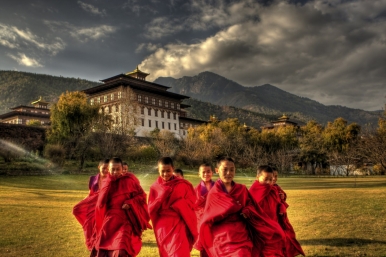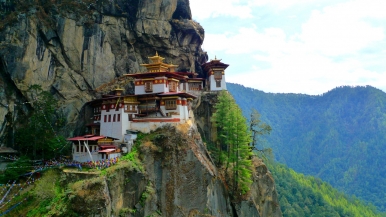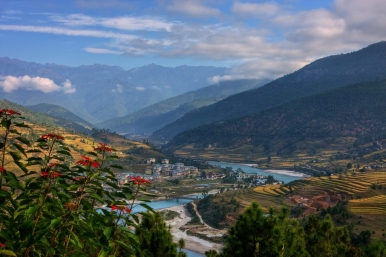Bhutan is living proof of ‘Shangri-La’, with its sacred Buddhist culture, exotic Himalayan beauty and untainted way of life

For years, the last Buddhist Kingdom, Bhutan, has been closed off from the world, with word of mouth that portrayed it as the elusive ‘Shangri-La’. When the kingdom finally loosened this law recently, it was expected for tourists to clamour for entry into this fabled realm.
_386_574.jpg)
Bhutan is a tiny, Himalayan kingdom wedged between India and China, thus a vital colliding point between both cultures. A total of 75% of the countryside remains untouched – Bhutanese still fiercely safeguard their environment as much as tradition. Unlike most countries, Bhutan’s productivity and development is measured through a unique philosophy of Gross National Happiness, the brainchild of King Jingme Singye Wangchuck. It’s a holistic approach prioritising the wellbeing of its people.
Behind its shroud of mystery, Bhutan is simply visually and culturally rewarding. Snow-capped mountain peaks, monasteries, picture-book worthy trails, vibrant flora and fauna, age-old crafts, and ceremonial festivals are just some that make up this spiritual place on earth.

Before you go…
All tourists, except Indian, Bangladeshi and Maldivian passport holders, require visas and compulsory holiday bookings through official Bhutanese tour operators or their international partners. In accordance the their tourism policy of “High Value, Low Impact”, visitors are required a Minimum Daily Package of USD $250 a day, which includes accommodation, food, transport and an official guide.
PLACES OF INTEREST
Paro Valley

Home to Bhutan’s oldest sacred sites, Paro is the cradle of dzong (fortress) architecture, ancient practices and natural beauty that soulfully depict the nation's tranquillity and quiet. Not to be missed is the iconic Taktsang Monastery, or Tiger’s Nest Hermitage, established as a scared place for meditation. Perched on the edge of a 1,200-meter cliff, the legendary pilgrimage site is undeniably a spectacular vision. Otherworldly architecture is still evident in Paro’s numerous monasteries, temples and traditional farm houses.
Haa Valley

The Queen Grandmother and Dorji family call Haa their ancestral home. Although it’s the smallest dzongkhag (district) in the country, its attractive landscape dotted with pristine alpine forests and serene mountain peaks makes it ideal for hiking and biking, boasting some of the best, timeworn trails in the Himalayas. Hilly, wooded paths lead to picturesque temples and a peek at lives of nomadic herders. Visit Haa Valley in its prime during the Summer Festival, when nomadic Bhutanese present their unaffected lifestyle and culture through sports, traditional dancing and singing performances, with more than enough scrumptious Haapi cuisine to go around.
Capital of Thimphu

The best place to relieve yourself outside of the tour itinerary is in this city that synchronising with a charm of both old customs and new refinements. Construction and commercialisation abound, and share space with monks, government ministers dressed in traditional ghos and kiras, and curious tourists. Bars, nightclubs, museums, sacred sites and specialist handicrafts exist side by side. Must visits include the resplendent Trashi Chhoe Dzong that hosts religious tsechu festivals and royal events, the illustrious National Textile Museum and the National Library built with traditional Bhutanese architecture.
National Parks

Bhutan would be the best place to view biological wonders of the Himalayas. Among its numerous national parks, the Jigme Dorji National Park is the largest protected site in Bhutan that covers 4,349 sq. km. The park encloses a diversity of flora, from forests to icy landscapes and glaciers towards the north, with revered summits like Jomolhari and Jichu Drakey, and meadows of flowers like the national blue poppy, edelweiss, and orchids. Enriching the topography are rare animal species such as the Snow Leopard, Royal Bengal Tiger, Blue Sheep and Red Panda, which call these forests and mountains home, too.
Changlimithang Stadium & Archery Ground

Bhutan’s national sport is archery, and they play it in a much different way. The best place to watch the sport in action is at the Changlimithang Stadium, the national stadium built on site of the historical 1885 battle. If you’re lucky enough to catch an archery tournament, particularly the Yangphel archery tournament, you’ll be given a privileged insight of their traditional version in terms of target placements but most of all, the good-humoured atmosphere. Archers are required to dress in full traditional attire – a great national costume showcase – while dancers and singers cheer or egg them on, to the audiences’ amusement.
Photo credits: King Jingme Singye Wangchuck, Bhutanese smiles, Paro Valley, Haa Valley, Jigme Dorji National Park, Capital of Thimphu, Jigme Dorji National Park, archery tournament with King Jingme









